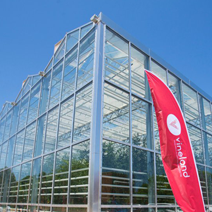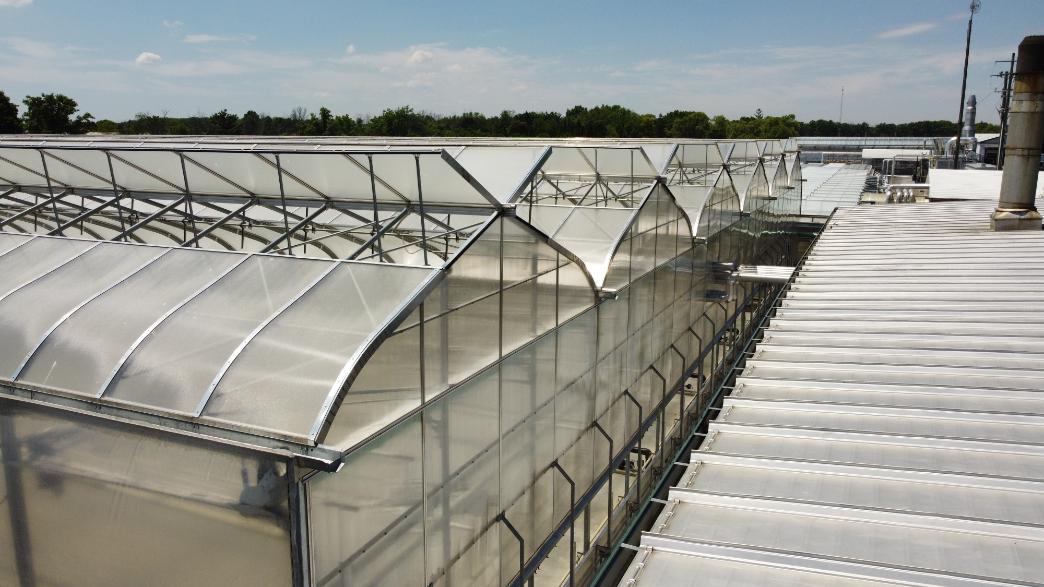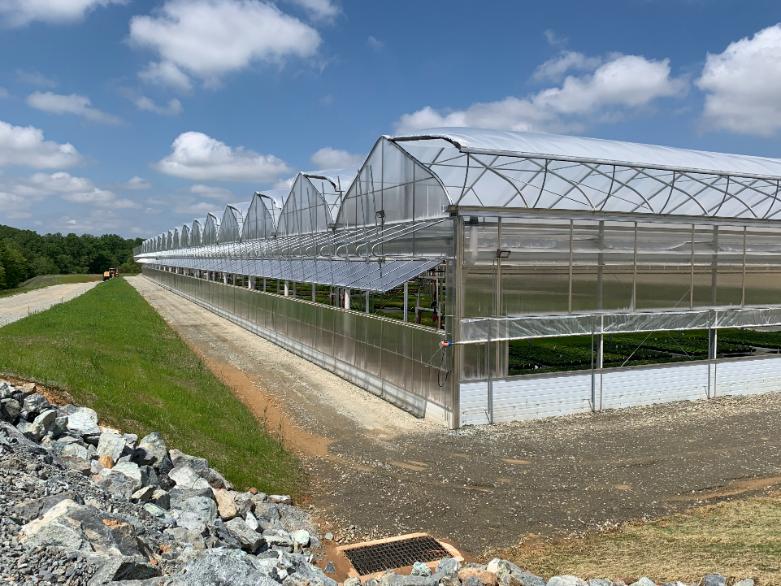How to Bench a Commercial Greenhouse
Benches are critically important to plant quality and labor costs.
Lets look at choices…
1. Growing On The Ground
Throw down some weed barrier and lay your crop right on the ground. No investment in benches needed beyond the weed barrier and you can rearrange your layout whenever you need.
a. Pros: Low cost, some flexibility in layout
b. Cons: Extra labor placing, spacing and lifting crop, Cold roots impact quality unless you put hot water heat in floor.
Typically I see these as wood frame with some type of mesh tabletop or steel and aluminum benches with expanded metal tops. Wood can be slightly less expensive that metal benches although there is a cost for upkeep and can make it hard to disinfect at year-end. Stationary benches are the right choice if you have a retail house but stationary benches do not use floor efficiency well – often with only 50% to 60% floor covering.
a. Pros: Gets crop up where you can more easily work, mesh tops and expanded metal tops improves air flow and improves plant quality, allows heat to go under the bench
b. Cons: Too many aisles reduce crop efficiency
Typically these are metal benches using an expanded metal mesh top. Rolling benches allow a house to reduce down to one aisle and still allow you to reach across any bench to water or load/pick your crop.
a. Pros: Improve crop efficiency with typically 80% + bench coverage, metal benches low maintenance, expanded metal allows good airflow and allows you to put heat under the bench.
b. Cons: One aisle means no retail – this is wholesale only configuration, must learn new labor techniques to keep efficient as it can be a long walk to one plant, more costly to install
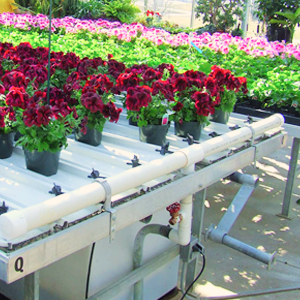
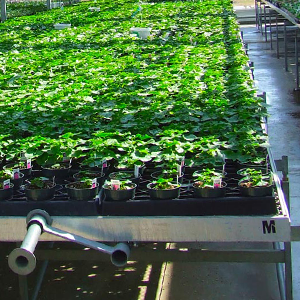
4. Traveling Benches
Here the benches move to you with a bench system designed to fill a house. You move the small, often 8’ x 15’ benches, on a series of rollers and conveyors to your planting area – then move the bench to your growing area. When shipping you pull whole bench out of the greenhouse to pick and pack the orders. While this might be the most expensive system to install there is real labor savings and utilization payback. Depending on the greenhouse and crop, these systems approach 95% bench utilization.
a. Pros: Dramatic improvement in labor efficiency, can automate using robots a number of tasks, best use of floor space.
b. Cons: Difficult to pick small orders. More expensive to install, requires greenhouse to be configured to take advantage of product flow.
Benches that are designed to sub-irrigate a crop. I have seen all sorts of flood benches from simple poly lined to fiberglass troughs to more sophisticated benches with hard plastic liners. This type of bench can be stationary, rolling or a traveling type depending on your under-frame. Key here is that your watering labor is reduced as well as crop uniformity improved and all runoff water is collected. Combining your bench system with your irrigation does have a few extra problems to solve – including making sure your benching system can handle not only the weight of your crop but also the added weight of the water. But the benefits of having a flood bench system should outweigh any engineering hurdles.
a. Pros: Highest quality crop with uniform watering through entire bench, reduced labor costs, allows water to be collected and reused.
b. Cons: Adding irrigation system to a bench system is most expensive option. Not a good retail setup (although better at retail than drip tubes)
6. Tiered Bench Displays
This is a retail configuration with goal of making it easier for shoppers to see and reach our products. I find most ‘benches’ are poor for consumers as we expect a shopper to bend over and reach. Compared to how typically clothing stores are set up where I see narrow shelves typically no deeper than 18” – a 5’ or 6’ wide greenhouse bench is just not consumer friendly. Most tiered displays use narrow width tops and then stack a few shelves at easy to reach heights. Many have a bar for hanging baskets. While you might not be able to put as many plants on a tiered display – they will sell more quickly – and give the shopper a more pleasant experience (and we all know those two things are completely linked…)
a. Pros: Better visual display, faster turn at retail
b. Cons: Can fewer plants than large wide benches, extra cost
So how do you decide what is best? Can you evolve from one system to another as your business changes? I am a big fan of the ‘business plan’ approach to managing your business. Your bench decisions should be driven by where you want the business to go.
Clearly if you are retail grower versus a wholesale grower there are logical paths.
Retail grower: Here you need a bench system set up for your customers – not for production, Questions to ask will be do you install permanent benches or do you have a concrete floor and benches that can be moved to fit season or display? Recognizing here that concrete floors are not a low cost option but may create a better shopping experience. As you think about benches think about customer flow, what will be most comfortable for them and effective for you to set displays?
Wholesale grower: Again based on your business plan, will your business be large enough to later install traveling benches – and if so would you set up your product and material flow a certain way now to avoid making massive production changes later? We often see growers keep crop on the ground for a few years then leap right into a traveling bench system.
My suggestion is that you work with a manufacturer who understands your business needs and can adapt a bench system to impact your plant quality, your labor and your overall success with customers.
Laurie Scullin is the owner of a product, idea and business development company – The New Product Group. Scullin has spent the last 20 years offering marketing support to some of the industry's top firms and has developed programs in use at independent garden centers, big-box chains and supermarkets across the United States and Canada.




